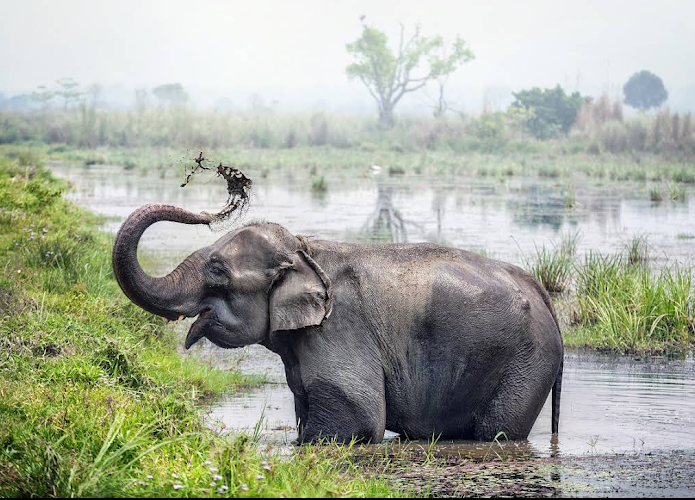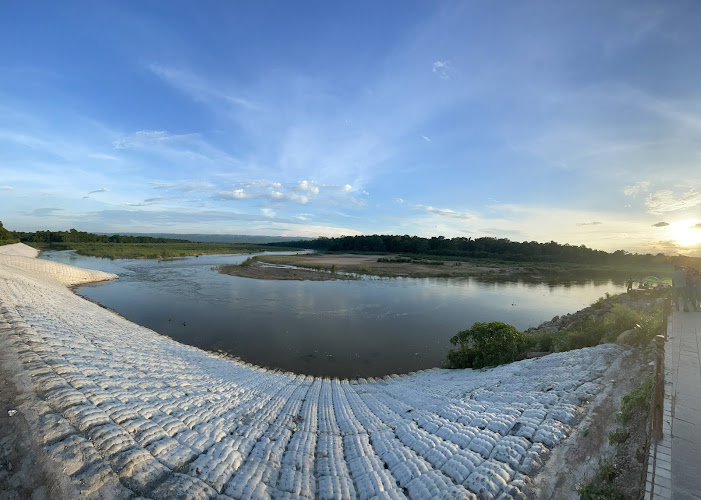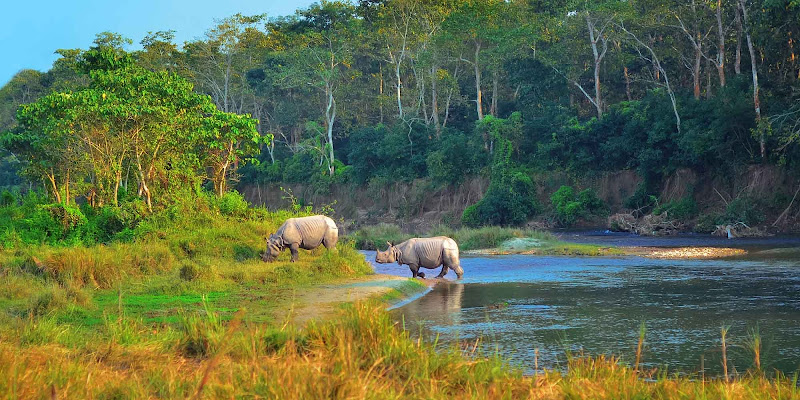



Chitwan national PARK - Nepal's Premier Wildlife Safari Destination with Tigers & Rhinos
NP
When Nepal established its first national park in 1973 along the flood plains of the Rapti River, fewer than 150 one-horned rhinoceros remained in the country. Today, more than 750 rhinos thunder through Chitwan's sal forests and grasslands, marking one of Asia's most dramatic wildlife recoveries. This 952-square-kilometer sanctuary in south-central Nepal didn't just save a species from extinction—it pioneered an entirely new approach to conservation that would inspire protected areas across the continent.
Stretching across the subtropical Terai lowlands, Chitwan National Park earned UNESCO World Heritage status in 1984 for its exceptional biodiversity and conservation achievements. The park's boundaries encompass the convergence of three major river systems—the Rapti, Narayani, and Budhi Rapti—creating a mosaic of riverine forests, oxbow lakes, and towering elephant grass that can reach heights of six meters. This intricate landscape supports more than 700 wildlife species, including 128 Bengal tigers counted in the most recent 2023 survey, a remarkable increase from the handful that survived when the park opened five decades ago.
The numbers tell an extraordinary story. From just 121 tigers nationwide in 2010 to 240 across Nepal's protected areas today, the country stands alone in nearly achieving the ambitious global goal of doubling tiger populations. Chitwan led this charge with military-backed anti-poaching patrols using drones, surveillance cameras, sniffer dogs, and armed soldiers. The results speak for themselves: Nepal celebrated four consecutive years of zero rhino poaching between 2011 and 2015, a feat unmatched anywhere in the rhino's range.
But Chitwan's wildlife riches extend far beyond its celebrity megafauna. The park harbors the world's highest density of sloth bears, with 200 to 250 individuals prowling through the forest undergrowth. More than 525 bird species fill the canopy and wetlands, from the critically endangered Bengal florican to massive flocks of sarus cranes that gather along the riverbanks. The Narayani-Rapti river system hosts both gharial and mugger crocodiles, including a population of the fish-eating gharial that has dwindled to just 38 individuals in these waters—making every sighting precious.
Most visitors base themselves in Sauraha, the bustling gateway village along the park's northern boundary at Tandi. This former farming settlement has evolved into a well-organized tourism hub while maintaining its riverside charm. From here, nine entrance gates provide access to different sections of the park, including Kasara (the park headquarters via Jagatpur), Ghatgain via Patihani, and the quieter Meghauli entrance along the Rapti River's southern banks. Each entry point offers distinct ecosystems and wildlife viewing opportunities.
The park experience begins before dawn, when naturalist-guided jungle walks lead small groups through morning mist to watering holes where rhinos bathe and deer graze at the forest edge. These walks offer what motorized safaris cannot—the intimate experience of tracking fresh tiger pugmarks, the rustle of a leopard retreating into bamboo thickets, or the distinctive alarm call of spotted deer signaling a predator's presence. For those preferring wheeled transport, open-roof jeep safaris navigate the network of dirt tracks that wind through sal forests and grassland clearings, particularly productive from late January through March when villagers cut the towering grass, dramatically improving visibility.
Canoe trips along the Rapti and Budhi Rapti rivers provide a different perspective entirely. Drifting silently past mudbanks where gharials bask with mouths agape for thermoregulation, paddlers spot kingfishers, storks, and egrets hunting in the shallows. The occasional rhino emerges from riverside vegetation to drink, while mugger crocodiles slip into the current, their powerful tails propelling them through the murky water.
The indigenous Tharu people form an inseparable part of Chitwan's cultural landscape. Their ancestors adapted to the malaria-plagued Terai centuries before modern medicine made the lowlands habitable for hill populations. Village tours through traditional Tharu settlements reveal beautifully painted mud houses adorned with intricate designs depicting folklore and daily life. Each evening in Sauraha, cultural programs showcase the mesmerizing Lathi Nach stick dance and the acrobatic Mayur Nach peacock dance, performances that have evolved from religious festivals into a vital source of community income and cultural preservation.
Timing a visit around the subtropical climate proves crucial for optimal wildlife viewing. October through March brings pleasant temperatures around 25 degrees Celsius and clear skies perfect for morning safaris. Late January to March offers the best game viewing as receding water sources concentrate animals around remaining waterholes and the grass-cutting season opens up sightlines. April and May turn oppressively hot, with temperatures soaring above 35 degrees, but wildlife viewing paradoxically improves as desperate animals converge on dwindling water sources. The monsoon months from June through September bring 80 percent of Nepal's annual rainfall, flooding forest tracks, obscuring animals in dense vegetation, and turning Sauraha into a muddy quagmire—most lodges simply close for the season.
The journey from Kathmandu covers 165 kilometers through the Mahabharat Range, a five to six-hour drive when traffic cooperates. Tourist buses depart Thamel at 6:45 AM daily, navigating the notorious traffic jams at Kalanki and Mugling before descending to the Terai plains. Those with tighter schedules can fly to Bharatpur in just 25 minutes, though at significantly higher cost. The winding descent from the Kathmandu Valley offers increasingly expansive views across the Terai's agricultural patchwork before the sal forests of Chitwan rise on the horizon.
Conservation success at Chitwan hasn't come without complications. A 766-square-kilometer buffer zone added in 1997 helps mitigate human-wildlife conflict, while electric fences and concrete barriers protect crops from marauding elephants and rhinos. Compensation schemes reimburse farmers for livestock killed by tigers and leopards, though the payments rarely match the actual economic loss. The tension between protecting wildlife and supporting local livelihoods remains an ongoing challenge, one that Chitwan continues pioneering solutions for even as its animals thrive.
From a sanctuary born of necessity when rhino populations teetered on the brink, Chitwan National Park has emerged as living proof that dedicated conservation can reverse even the most dire trajectories. Those 694 rhinos counted in the 2021 census, the 128 tigers prowling the sal forests, and the 525 bird species filling the wetlands represent more than statistics—they embody a commitment that transformed 952 square kilometers of threatened habitat into one of Asia's most important wildlife refuges.
Park Features & Amenities
🛠️ Service options
- ✓ On-site services
♿ Accessibility
- ✓ Wheelchair-accessible car park
- ✓ Wheelchair-accessible entrance
🏃 Activities
- ✓ Hiking
🏗️ Amenities
- ✓ Barbecue grill
- ✓ Picnic tables
- ✓ Public toilet
- ✓ Slides
- ✓ Swings
- ✓ Volleyball court
🎠 Children
- ✓ Good for kids
- ✓ Good for kids birthday
- ✓ Kid-friendly hikes
- ✓ Playground
🐕 Pets
- ✓ Dog park
- ✓ Dogs allowed
Visitor Information
🕐 Best Times to Visit
Spring (Mar-May): Pleasant weather, blooming flowers
Autumn (Sep-Nov): Clear skies, comfortable temperatures
Early Morning: Best for wildlife viewing and photography
🗺️ Getting There
By Car: Address available on contact
Public Transport: Local buses and taxis available
Walking: Check distance from city center
💡 Visitor Tips
• Bring water and sun protection
• Wear comfortable walking shoes
• Check weather conditions before visiting
• Bring camera for nature photography
Explore More in Nepal
Nearby Attractions
Ready to Visit Chitwan national PARK?
Plan your visit to this amazing destination with our comprehensive travel guide and insider tips.
Seasonal Travel Guide
Weather & Best Time
Winter brings cool temperatures (5-15°C) with clear skies and snow-capped peaks. Perfect for mountain views but cold at higher altitudes.
Best Activities:
- Mountain viewing
- Cultural experiences
- Spa and hot springs
- Photography of snow peaks
- Indoor cultural activities
Travel Tips
- Visit during December-February for snow-capped views
- Pack warm clothing for cold temperatures
- Book hotels with heating facilities
- Plan for shorter daylight hours
Packing Suggestions:
- Warm winter clothing
- Thermal layers
- Warm hat and gloves
- Sturdy winter boots
- Hot water bottle
Quick Facts
Best time: Autumn (Sep-Nov)
Duration: 1-3 days
Difficulty: Easy
Cost: Budget-friendly